语言学第8章
- 格式:doc
- 大小:102.50 KB
- 文档页数:5
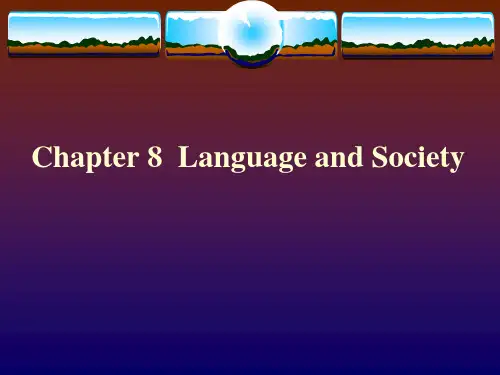
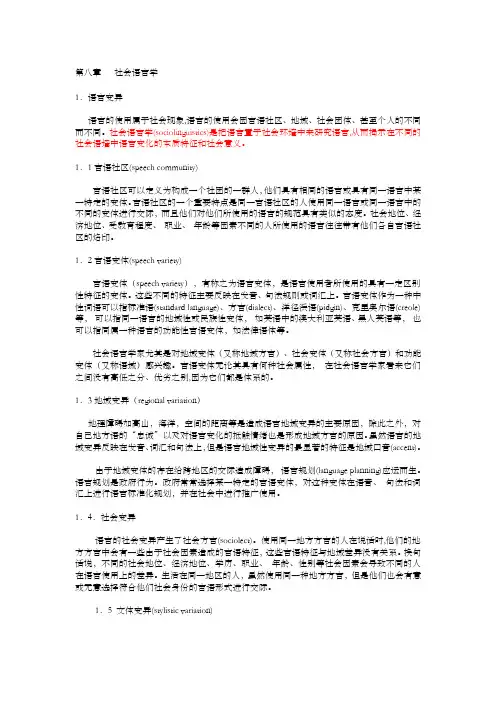
第八章社会语言学1.语言变异语言的使用属于社会现象,语言的使用会因言语社区、地域、社会团体、甚至个人的不同而不同。
社会语言学(sociolinguistics)是把语言置于社会环境中来研究语言,从而揭示在不同的社会语境中语言变化的本质特征和社会意义。
1.1言语社区(speech community)言语社区可以定义为构成一个社团的一群人,他们具有相同的语言或具有同一语言中某一特定的变体。
言语社区的一个重要特点是同一言语社区的人使用同一语言或同一语言中的不同的变体进行交际,而且他们对他们所使用的语言的规范具有类似的态度。
社会地位、经济地位、受教育程度、职业、年龄等因素不同的人所使用的语言往往带有他们各自言语社区的烙印。
1.2言语变体(speech variety)言语变体(speech variety),有称之为语言变体,是语言使用者所使用的具有一定区别性特征的变体。
这些不同的特征主要反映在发音、句法规则或词汇上。
言语变体作为一种中性词语可以指标准语(standard language)、方言(dialect)、洋径浜语(pidgin)、克里奥尔语(creole)等,可以指同一语言的地域性或民族性变体,如英语中的澳大利亚英语、黑人英语等,也可以指同属一种语言的功能性言语变体,如法律语体等。
社会语言学家尤其是对地域变体(又称地域方言)、社会变体(又称社会方言)和功能变体(又称语域)感兴趣。
言语变体无论其具有何种社会属性,在社会语言学家看来它们之间没有高低之分、优劣之别,因为它们都是体系的。
1.3地域变异(regional variation)地理障碍如高山,海洋,空间的距离等是造成语言地域变异的主要原因,除此之外,对自己地方语的“忠诚”以及对语言变化的抵触情绪也是形成地域方言的原因。
虽然语言的地域变异反映在发音、词汇和句法上,但是语言地域性变异的最显著的特征是地域口音(accent)。
由于地域变体的存在给跨地区的交际造成障碍,语言规划(language planning)应运而生。
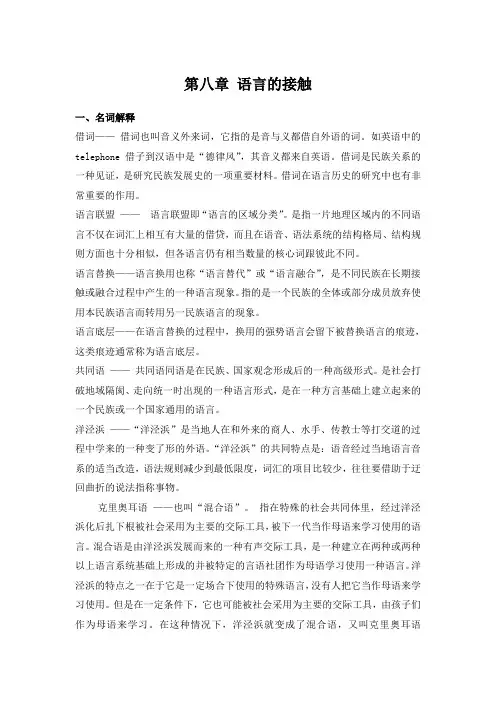
第八章语言的接触一、名词解释借词——借词也叫音义外来词,它指的是音与义都借自外语的词。
如英语中的telephone借子到汉语中是“德律风”,其音义都来自英语。
借词是民族关系的一种见证,是研究民族发展史的一项重要材料。
借词在语言历史的研究中也有非常重要的作用。
语言联盟——语言联盟即“语言的区域分类”。
是指一片地理区域内的不同语言不仅在词汇上相互有大量的借贷,而且在语音、语法系统的结构格局、结构规则方面也十分相似,但各语言仍有相当数量的核心词跟彼此不同。
语言替换——语言换用也称“语言替代”或“语言融合”,是不同民族在长期接触或融合过程中产生的一种语言现象。
指的是一个民族的全体或部分成员放弃使用本民族语言而转用另一民族语言的现象。
语言底层——在语言替换的过程中,换用的强势语言会留下被替换语言的痕迹,这类痕迹通常称为语言底层。
共同语——共同语同语是在民族、国家观念形成后的一种高级形式。
是社会打破地域隔阂、走向统一时出现的一种语言形式,是在一种方言基础上建立起来的一个民族或一个国家通用的语言。
洋泾浜——“洋泾浜”是当地人在和外来的商人、水手、传教士等打交道的过程中学来的一种变了形的外语。
“洋泾浜”的共同特点是:语音经过当地语言音系的适当改造,语法规则减少到最低限度,词汇的项目比较少,往往要借助于迂回曲折的说法指称事物。
克里奥耳语——也叫“混合语”。
指在特殊的社会共同体里,经过洋泾浜化后扎下根被社会采用为主要的交际工具,被下一代当作母语来学习使用的语言。
混合语是由洋泾浜发展而来的一种有声交际工具,是一种建立在两种或两种以上语言系统基础上形成的并被特定的言语社团作为母语学习使用一种语言。
洋泾浜的特点之一在于它是一定场合下使用的特殊语言,没有人把它当作母语来学习使用。
但是在一定条件下,它也可能被社会采用为主要的交际工具,由孩子们作为母语来学习。
在这种情况下,洋泾浜就变成了混合语,又叫克里奥耳语(Creole,是混血儿的意思)二、填空1、语言发生接触的前提条件是(社会的接触)2、语言接触从根本上说是(使用语言的人之间)接触。

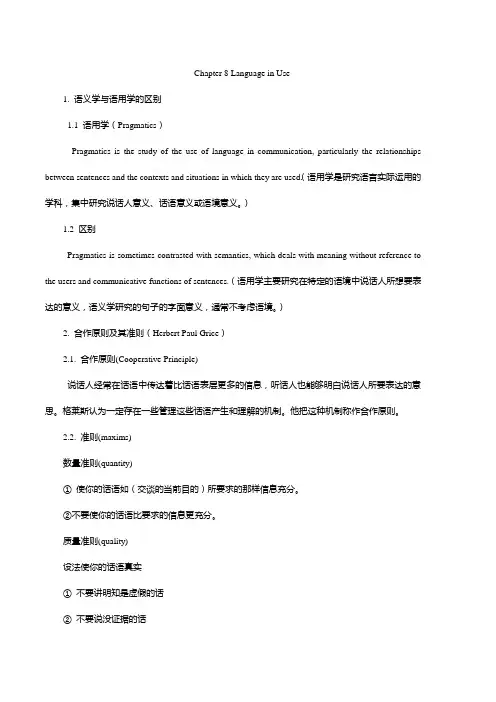
Chapter 8 Language in Use1. 语义学与语用学的区别1.1 语用学(Pragmatics)Pragmatics is the study of the use of language in communication, particularly the relationships between sentences and the contexts and situations in which they are used.(语用学是研究语言实际运用的学科,集中研究说话人意义、话语意义或语境意义。
)1.2 区别Pragmatics is sometimes contrasted with semantics, which deals with meaning without reference to the users and communicative functions of sentences.(语用学主要研究在特定的语境中说话人所想要表达的意义,语义学研究的句子的字面意义,通常不考虑语境。
)2. 合作原则及其准则(Herbert Paul Grice)2.1. 合作原则(Cooperative Principle)说话人经常在话语中传达着比话语表层更多的信息,听话人也能够明白说话人所要表达的意思。
格莱斯认为一定存在一些管理这些话语产生和理解的机制。
他把这种机制称作合作原则。
2.2. 准则(maxims)数量准则(quantity)①使你的话语如(交谈的当前目的)所要求的那样信息充分。
②不要使你的话语比要求的信息更充分。
质量准则(quality)设法使你的话语真实①不要讲明知是虚假的话②不要说没证据的话关系准则(relation)所谈内容要密切相关方式准则(manner)要清晰。
①避免含糊不清②避免歧义③要简练(避免冗长)④要有序3. 言语行为理论(Speech Act Theory)---John Austin3.1. 施为句&叙事句(Performatives & Constatives)施为句是用来做事的,既不陈述事实,也不描述情况,且不能验证真假;叙事句要么用于陈述,要么用于验证,可以验证真假。
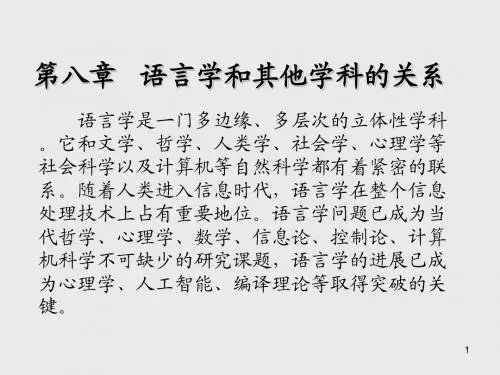
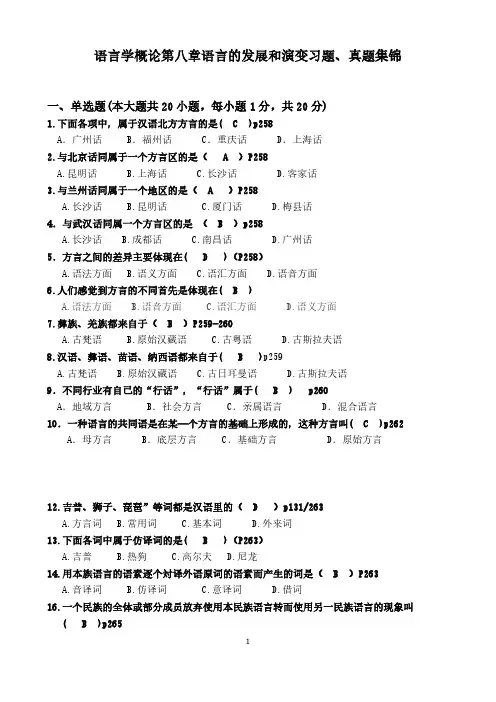
语言学概论第八章语言的发展和演变习题、真题集锦一、单选题(本大题共20小题,每小题1分,共20分)1.下面各项中,属于汉语北方方言的是( C )p258A.广州话 B.福州话 C.重庆话 D.上海话2.与北京话同属于一个方言区的是( A )P258A.昆明话B.上海话C.长沙话D.客家话3.与兰州话同属于一个地区的是( A )P258A.长沙话B.昆明话C.厦门话D.梅县话4.与武汉话同属一个方言区的是( B )p258A.长沙话B.成都话C.南昌话D.广州话5.方言之间的差异主要体现在( D )(P258)A.语法方面B.语义方面C.语汇方面D.语音方面6.人们感觉到方言的不同首先是体现在( B )A.语法方面B.语音方面C.语汇方面D.语义方面7.彝族、羌族都来自于( B )P259-260A.古梵语B.原始汉藏语C.古粤语D.古斯拉夫语8.汉语、彝语、苗语、纳西语都来自于( B )p259A.古梵语B.原始汉藏语C.古日耳曼语D.古斯拉夫语9.不同行业有自己的“行话”,“行话”属于( B ) p260A.地域方言 B.社会方言 C.亲属语言 D.混合语言10.一种语言的共同语是在某—个方言的基础上形成的,这种方言叫( C )p262 A.母方言 B.底层方言 C.基础方言 D.原始方言12.吉普、狮子、琵琶”等词都是汉语里的( D )p131/263A.方言词B.常用词C.基本词D.外来词13.下面各词中属于仿译词的是( B )(P263)A.吉普B.热狗C.高尔夫D.尼龙14.用本族语言的语素逐个対译外语原词的语素而产生的词是( B )P263A.音译词B.仿译词C.意译词D.借词16.一个民族的全体或部分成员放弃使用本民族语言转而使用另一民族语言的现象叫( B )p265A.语言混合 B.语言转用 C.克里奥尔 D.双语现象17.语言的替换必然要经历( D )P266A.洋泾滨语阶段B.融合语阶段C.失语阶段D.双语阶段18.语言替换又被视为( B )P265A.语言混用B.语言转用C.语音混合D.语言渗透19.下列关于语言转用的表述,不正确的一项是( C )P265A.语言转用是语言统一的重要形式B.双语现象并非一定导致语言转用C.语言转用以民族融合为必要条件D.语言间的密切接触是语言转用的重要条件20.方言和亲属语言之间具有( A )P259A.语音对应关系B.语汇对应关系C.语义对应关系D.语音对应关系22.亲属语言产生的必要社会条件是(A)P259A.社会的完全地域分化B.社会的不完全地域分化C.社会的完全社群分化D.社会的不完全是社群分化23.语言间亲属关系的重要标志是( D ) P259A.语义对应B.词汇对应关系C.语法对应关系D.语音对应关系24.通常被看作语言亲属关系重要证据的是( B )P259A.语言类型相同 B.语音对应关系 C.地理位置相近 D.语言借用成25.克里奥耳语又叫做( C )P266-268A.皮琴语B.复综语C.混合语D.语言联盟26.洋泾浜语和克里奥耳语属于( C ) P266A.语言的借用B.语言的转用C.语言的混合D.双语现象。
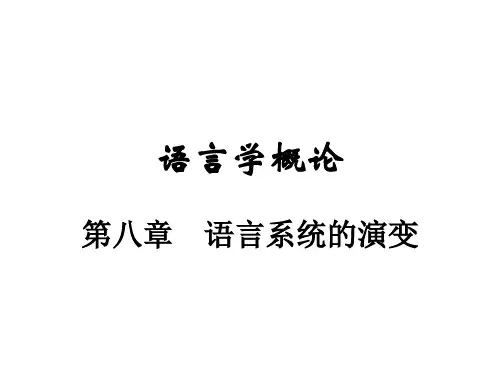

第八章语言的发展名词解释。
1共同语:一个社会的全体成员或大多数人日常生活中使用的语言叫做共同语。
在没有方言分歧的社会里,全体社会成员所使用的语言都是共同语。
2.方言:3.地域方言:地域方言也叫“地区方言”,是全民语言在不同地域的变体,是统一的全民语言的分支。
它是最为常见的语言分化现象。
4.社会方言:由于社会中的人们所处社会地位、职业、年龄、性别、文化高低等方面存在着许多差异,这些差异必然使人们在运用语言方面形成某些个性化或类型化的特点,从而形成了社会方言,各种行业语、阶级方言、黑话等,都属于社会方言。
社会方言也是全民语言的社会变体,是语言分化的结果。
5.亲属语言:凡是从同一种语言分化出来的若干种独立的语言,它们就是亲属语言,亲属语言也是语言分化的结果。
6.标准语:7.克里奥尔语:克里奥尔语是指在各种语言频繁接触的地区出现的一种包含不同语言成分混合自然语言。
8.底层:在语言融合的过程中,胜利的语言也必将从失败的语言中吸收一些成分来丰富自己。
或者说,被同化的语言不会马上彻底消失,还会有一些成分遗留在同化的语言中,这种现象就是底层现象。
复习思考题。
1.谈一谈语言发展的原因和特点。
(1)语言发展的原因:外因:社会的发展是语言发展的基本条件语言是人类最重要的交际工具,它随着社会的产生而产生,随着社会的发展而发展,社会的发展是语言发展的基本条件。
①社会进步推动语言的发展:随着社会生产力的发展,生产关系的改变,以及社会生活的变化,新事物、新概念不断出现,这就要求语言要不断地产生各种各样的词语以适应交际的需要。
②社会的分化和统一推动语言的发展:语言是全社会的交际工具,当社会走向分化的时候,这个社会的各个部分之间交际就会逐渐减少,各个部分成员使用的语言就会产生差异,逐渐形成不同的方言或语言。
另外,由于社会分工的存在,使社会上形成了不同的社会集团,各个集团在语言使用上会形成不同的特点,从而形成社会方言。
反之,如果已经分化的社会各个部分或不同社会之间逐渐走向统一,语言或方言之间的影响加强,促使语言逐渐趋向统一。
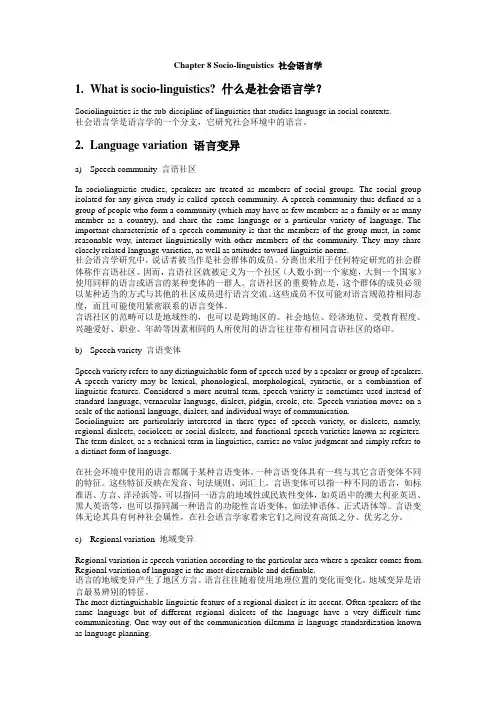
Chapter 8 Socio-linguistics 社会语言学1.What is socio-linguistics? 什么是社会语言学?Sociolinguistics is the sub-discipline of linguistics that studies language in social contexts.社会语言学是语言学的一个分支,它研究社会环境中的语言。
nguage variation 语言变异a)Speech community 言语社区In sociolinguistic studies, speakers are treated as members of social groups. The social group isolated for any given study is called speech community. A speech community thus defined as a group of people who form a community (which may have as few members as a family or as many member as a country), and share the same language or a particular variety of language. The important characteristic of a speech community is that the members of the group must, in some reasonable way, interact linguistically with other members of the community. They may share closely related language varieties, as well as attitudes toward linguistic norms.社会语言学研究中,说话者被当作是社会群体的成员。
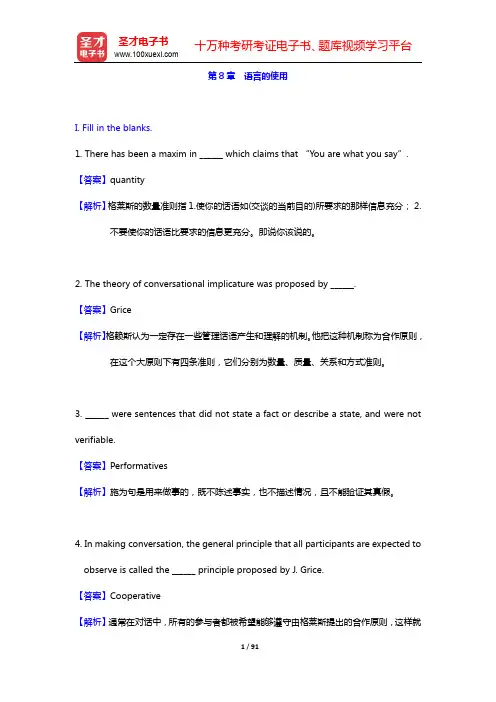
第8章语言的使用I. Fill in the blanks.1. There has been a maxim in ______ which claims that “You are what you say”. 【答案】quantity【解析】格莱斯的数量准则指1.使你的话语如(交谈的当前目的)所要求的那样信息充分;2.不要使你的话语比要求的信息更充分。
即说你该说的。
2. The theory of conversational implicature was proposed by ______.【答案】Grice【解析】格赖斯认为一定存在一些管理话语产生和理解的机制。
他把这种机制称为合作原则,在这个大原则下有四条准则,它们分别为数量、质量、关系和方式准则。
3. ______ were sentences that did not state a fact or describe a state, and were not verifiable.【答案】Performatives【解析】施为句是用来做事的,既不陈述事实,也不描述情况,且不能验证其真假。
4. In making conversation, the general principle that all participants are expected to observe is called the ______ principle proposed by J. Grice.【答案】Cooperative【解析】通常在对话中,所有的参与者都被希望能够遵守由格莱斯提出的合作原则,这样就不会有会话含义的产生。
5. In the light of the ______ principle, four maxims are specified.They are the maxim of quantity, maxim of ______, maxim of ______ and the maxim of _____.【答案】cooperative; quality; relation; manner【解析】考查合作原则及四条次则:数量准则、质量准则、关联准则、方式准则。
语言学教程第二版第八章答案I. Read each of the following statements and questions carefully. Choose the letter A, B, C or D to complete the statement or to answer the question. (2.5* 20= 50 Scores)1. Linguistics is the scientific study of______. [单选题] *A. a particular languageB. the English languageC. human languages in general(正确答案)D. the system of a particular language2. What function does the following dialogue have according to the functions of language?-- A nice day, isn’t it?--Right! I really enjoy the sunlight.[单选题] *A. Emotive.B. Phatic.(正确答案)C. Performative.D. Interpersonal.3. Language can be used to talk about language itself, to help listeners or readers to get clues about the logicial thoughts or attitudes etc of the speakers’ or the writers’. Such language function is called _____. [单选题] *A. phatic function.B. recreational function.C. emotive function.D. metalingual function.(正确答案)4. If a linguistic study describes and analyzes the language people actually use, it is said to be _______. [单选题] *A. prescriptiveB. analyticC. descriptive(正确答案)D. linguistic5. Saussure took a(n) _______ view of language, while Chomsky looks at language froma ________ point of view. [单选题] *A. sociological…psychological(正确答案)B. psychological…sociologicalC. applied…pragmaticD. semantic…linguistic6. Which is the branch of linguistics that studies the characteristics of speech sounds and provides methods for their description, classification and transcription? [单选题] *A. Phonetics(正确答案)B. PhonologyC. SemanticsD. Pragmatics7. The core branch of linguistics excludes ______. [单选题] *A. semanticsB. morphologyC. phoneticsD. psycholinguistics(正确答案)8. Of all the speech organs, the _____ is/are the most flexible. [单选题] *A. mouthB. lipsC. tongue(正确答案)D. vocal cords9. A _____ vowel is one that is produced with the front part of the tongue maintaining the highest position. [单选题] *A. backB. centralC. front(正确答案)D. middle10. Open vowels don’t contain _______. [单选题] *A. [i](正确答案)B. [a]C. [a:]D. [ɔ]11. The naming theory was put forward by _______. [单选题] *A. Plato(正确答案)B. ChomskyC. Ogden RichardD. Firth12. “Male”and" female"are _________. [单选题] *A. stylistic antonymsB. relational antonymsC. gradable antonymsD. complementary antonyms(正确答案)13. “Can I borrow your bike?”_________“You have a bike”. [单选题] *A. is synonymous withB. presupposes(正确答案)C. entailsD. is inconsistent with14. Modern linguistics regards the written language as ________. [单选题] *A. primaryB. correctC. secondary(正确答案)D. stable15. The core branch of linguistics excludes ______. [单选题] *A. semanticsB. morphologyC. phoneticsD. psycholinguistics(正确答案)16. According to Chomsky, which is the ideal user’s internalized knowledge of his language? [单选题] *A. Competence(正确答案)B. ParoleC. PerformanceD. Langue17. Unlike animal communication systems, human languag is _____. [单选题] *A. stimulus-free(正确答案)B. stimulus-drivenC. under immediate stimulus controlD. simulated by some occurrence of communal interest18. Among the three metafunctions of languages proposed by Halliday (1994), _____, the participatory function of langauge, enacts social relationships and textual function creates relevance to context. [单选题] *A. ideational function.B. interpersonal function.(正确答案)C. textual function.D. perfomative function19. Language can be used to refer to contexts removed from the immediate situations of the speaker. This feature is called _______. [单选题] *A. displacement(正确答案)B. dualityC. flexibilityD. cultural transmission20. The details of any language system is passed on from one generation to the next through _______, rather than by instinct. [单选题] *A. learningB. teachingC. booksD. both A and B(正确答案)II. Fill in the blank in each of the following statements with a word or words, the first letter of which is already given as a clue. (2.5* 20= 50 Scores)21. D_____ is one of the design features of human language which refers to the phenomenon that langauge consists of two levels: a lower level of meaningless individual sounds and a higher level of meaningful units. [填空题] *_________________________________(答案:uality)22. Language is p______ in that it makes possible the construction and interpretation of new signals by its users. In other words, they can produce and understand an infinitely large number of sentences which they have never heard before. [填空题] *_________________________________(答案:roductive)23. T______ function of language creates relevance to context and enables us to construct texts out of our utterances and writings. [填空题] *_________________________________(答案:extual)24. Chomsky defines “competence” as the ideal user’s k______of the rules of his language. [填空题] *_________________________________(答案:nowledge)25. Langue refers to the a______ linguistic system shared by all the members of a speech community while the parole is the concrete use of the conventions and application of the rules. [填空题] *_________________________________(答案:bstract)26. P_______ refers to the realization of langue in actual use. [填空题] *_________________________________(答案:arole)27. S_______ is the father of modern linguistics. [填空题] *_________________________________(答案:aussure)28. S________ is the study of the meaning of words and sentences. [填空题] *_________________________________(答案:emantics)29. Linguistic study in the 19th century was primarily about the d_______ studies. [填空题] *_________________________________(答案:iachronic)30. IPA indicates International Phonetics A______. [填空题] *_________________________________(答案:lphabet)31. A c_____ is a speech sound that is articulated with complete or partial closure of the vocal tract. [填空题] *_________________________________(答案:onsonant)32. E_______ is a relation of inclusion. [填空题] *_________________________________(答案:ntailment)33. "There"and"their" are h_______. [填空题] *_________________________________(答案:omophones)34. "Light"and"heavy are g_______ antonyms. [填空题] *_________________________________(答案:radable)35. I________ function of language enacts social relationships. [填空题] *_________________________________(答案:nterpersonal)36. The d_____ theory sees that the origin of language is from people’s response to the things around them by sounds. [填空题] *_________________________________(答案:ing-dong)37. Human capacity for language has a g________ basis, but the details of language have to be taught and learned. [填空题] *_________________________________(答案:enetic)38. C_______ analysis is based on the belief that the meaning of a word can be divided into meaning components. [填空题] *_________________________________(答案:omponential)39. P______ function of language can be used to maintain comfortable social relationship between speakers. [填空题] *_________________________________(答案:hatic)40. Lanauge is v________ as the primary medium for all languges is sound. [填空题] * _________________________________(答案:ocal)。
语言学概论名词解释第八章语言和心理感性思维:狭义的感性思维只指运用感觉器官感受外界事物的活动,是一种直观思维。
广义的感性思维还包括唤起表象并在想象中对表象加工改造的活动。
抽象思维:以概念、判断和推理等复杂逻辑形式进行的思维活动叫做抽象思维,也称理性思维,逻辑思维,或者统称思维活动。
发散思维:是指随着感性认识和理性认识而产生的综合心理活动,如感情、意志、美感和相关的文化传统意识等。
直观思维:是指运用感觉器官感受外界事物的活动。
表象思维:是指唤起表象并在想象中对表象加工改造的活动。
语言思维:是指必须使用语言进行的思维活动,即抽象思维。
非语言思维:是指抽象思维以外的思维活动。
失语症:因大脑的不同部位受到损伤而造成的语言障碍统称为失语症。
“模仿说”:是解释儿童语言获得原因的一种理论,它认为儿童是通过对大人语言模仿来掌握语言的。
模仿说不无道理,但过于强调外部条件。
“强化说”:是解释儿童语言获得原因的一种理论。
这一理论跟模仿说有联系,但认为儿童除了模仿更重要的是通过不断受到外界的强化刺激来形成语言习惯。
其理论来源是“条件反射”理论以及“刺激反应”理论。
然而事实上有目的的强化刺激在现实生活中并不存在。
“天赋说”:是建立在乔姆斯基提出的关于大脑中存在语言遗传机制这样一种假设基础上的解释。
根据这种解释,人的语言只是中至少有一部分,即一些基本的类别范畴和语法原则是通过生物进化和遗传得到的,然后通过后天接触的语言环境不断加以调整和补充,最后才获得完整的语言知识。
而在先天具备的能力和后天补充的知识两方面中,先天的语言能力起到了最主要的内因作用。
“认知说”:认为在儿童语言获得过程中既有遗传机制的作用,又有语言环境的作用,或者说二者是相互作用。
这种理论是建立在皮亚杰提出的认知心理学的基础上的。
Decide whether each of the following statements is True or False:1. Sociolinguistics is the sub-discipline of linguistics that studies social contexts. F2. Language as a means of social communication is a homogeneous system with a homogeneous group of speakers. F3. Language use varies from one speech community to another, from one regional group to another, from one social group to another, and even from one individual to another. T4. The goal of sociolinguistics is to explore the nature of language variation and language use among a variety of speech communities and in different social situations. T5. The linguistic markers that characterize individual social groups may serve as social markers of group membership. T6. From the sociolinguistic perspective, the term “speech variety ” can not be used to refer to standard language, vernacular language, dialect or pidgin. F7.Functional speech varieties are known as regional dialects. F8. The most distinguishable linguistic feature of a regional dialect is its grammar and uses of vocabulary. F9.Geographical barriers are the only source of regional variation of language. F10. A person’s social backgrounds do not exert a shaping influence on his choice of linguistic features. F11.Two speakers of the same language or dialect use their language or dialect in the same way. F12. Every speaker of a language is, in a stricter sense, a speaker of a distinct idiolect. T13. The standard language is a better language than nonstandard languages. F14. A lingua franca can only be used within a particular country for communication among groups of people with different linguistic backgrounds. F15.Pidgins are linguistically inferior to standard languages. F16. A pidgin usually reflects the influence of the higher, or dominant, language in its lexicon and that of the lower language in their phonology and occasionally syntax. T17.The major difference between a pidgin and a creole is that the former usually has its native speakers while the latter doesn’t. F18.Bilingualism and diglossia mean the same thing. F19.The kind of name or term speakers use to call or refer to someone may indicate something of their social relationship to or personal feelings about that individual. T20.The use of euphemisms has the effect of removing derogatory overtones and the disassociative effect as such is usually long-lasting. FII. Fill in each of the blanks below with one word which begins with the letter given:21. The social group isolated for any given study is called the speech c___ community _____.22. Speech v_____ variety ____ refers to any distinguishable form of speech used by a speaker or group of speakers.23. From the sociolinguistic perspective, a speech variety is no more than a d_____ dialectal _____ variety of a language.24. Language standardization is also called language p___ planning ____.25. Social variation gives rise to s__ sociolects _______ which are subdivisible into smaller speech categories that reflect their socioeconomic, educational, occupational background, etc. 26. S_____ Stylistic __ variation in a person’s speech or writing usually ranges on a continuumfrom casual or colloquial to formal or polite according to the type of communicative situation. 27. A regional dialect may gain status and become standardized as the national or o____ official ____ language of a country.28. The standard language is a s_____ superimposed ____, socially prestigious dialect of language.29. Language varieties other than the standard are called nonstandard, or v____ vernacular___ languages.30. A pidgin typically lacks in i_ inflectional __ Idiolect____ morphemes.31. Linguistic taboo reflects s___social______ taboo.32. The avoidance of using taboo language mirrors social attitudes, emotions and value judgments and has no l_____ linguistic____ basis.III. There are four choices following each statement. Mark the choice that can best complete the statement:33. _______ is concerned with the social significance of language variation and language use in different speech communities.A. PsycholinguisticsB. SociolinguisticsC. Historical linguisticsD. General linguistics34. The most distinguishable linguistic feature of a regional dialect is its _____.A. use of wordsB. use of structuresC. accentD. morphemes35. ____ is speech variation according to the particular area where a speaker comes from.A. Regional variationB. Language variationC. Social variationD. Register variation36. _______ are the major source of regional variation of language.A. Geographical barriersB. Loyalty to and confidence in one’s native speechC. Physical discomfort and psychological resistance to changeD. Social barriers37. _________ means that certain authorities, such as the government choose, a particular speech variety, standardize it and spread the use of it across regional boundaries.A. Language interferenceB. Language changesC. Language planningD. Language transfer38. _________ in a person’s speech or writing usually ranges on a conti nuum from casual or colloquial to formal or polite according to the type of communicative situation.A. Regional variationB. Changes in emotionsC. Variation in connotationsD. Stylistic variation39. A ____ is a variety of language that serves as a medium of communication among groups of people for diverse linguistic backgrounds .A. lingua francaB. registerC. CreoleD. national language40. Although _______ are simplified languages with reduced grammatical features, they are rule-governed, like any human language.A. vernacular languagesB. creolesC. pidginsD. sociolects41. In normal situations, ____ speakers tend to use more prestigious forms than their ____ counterparts with the same social background.A. female; maleB. male; femaleC. old; youngD. young; old42. A linguistic ____ refers to a word or expression that is prohibited by the "polite" society from general use.A. slangB. euphemismC. jargonD. tabooIV. Define the following terms:43. sociolinguistics 44. speech community45. speech variety 46. language planning47. idiolect 48. standard language49. nonstandard language 50. lingua franca51. pidgin 52. Creole53. diglossia 54. Bilingualism55. ethnic dialect 56. Sociolect57. register 58. slang59. taboo 60. euphemismIV. Define the following terms:36. sociolinguistics: Sociolinguistics is the study of language in social contexts.37. speech community: The social group isolated for any given study is called the speech community or a speech community is a group of people who form a community and share the same language or a particular variety of language. The important characteristic of a speech community is that the members of the group must, in some reasonable way, interact linguistically with other members of the community. They may share closely related language varieties, as well as attitudes toward linguistic norms.38. speech variety: Speech variety, also known as language variety, refers to any distinguishable form of speech used by a speaker or group of speakers. The distinctive characteristics of a speech variety may be lexical, phonological, morphological, syntactic, or a combination of linguistic features.39. language planning: language standardization is known as language planning. This means that certain authorities, such as the government or government agency of a country, choose a particular speech variety and spread the use of it, including its pronunciation and spelling systems, across regional boundaries.40. Idiolect: An idiolect is a personal dialect of an individual speaker that combines aspects of all the elements regarding regional, social, and stylistic variation, in one form or another. In a narrower sense, what makes up one’s idiolect includes also such factors as voice q uality, pitch and speech rhythm, which all contribute to the identifying features in an individual' s speech.41.standard language: The standard language is a superposed, socially prestigious dialect of language. It is the language employed by the government and the judiciary system, used by themass media, and taught in educational institutions, including school settings where the language is taught as a foreign or second language.42.pidgin: A pidgin is a variety of language that is generally used by native speakers of other languages as a medium of communication.43. Creole: A Creole language is originally a pidgin that has become established as a native language in some speech community.44.diglossia: Diglossia usually describes a situation in which two very different varieties of language co-exist in a speech community, each with a distinct range of purely social function and appropriate for certain situations.45. Bilingualism: Bilingualism refers to a linguistic situation in which two standard languages are used either by an individual or by a group of speakers, such as the inhabitants of a particular region or a nation.46. ethnic dialect: Within a society, speech variation may come about because of different ethnic backgrounds . An ethnic language variety is a social dialect of a language, often cutting across regional differences. An ethnic dialect is spoken mainly by a less privileged population that has experienced some form of social isolation, such as racial discrimination or segregation.47. Sociolect: Social dialects, or sociolects, are varieties of language used by people belonging to particular social classes.48. register: Registers are language varieties which are appropriate for use in particular speech situations, in contrast to language varieties that are associated with the social or regional grouping of their customary users. Format reason, registers are also known as situational dialects .According to Ferguson's investigation, the high form of a language is used in all the following situations in a diglossic country EXCEPT ________.选择一项:a. caption on political cartoonb. news broadcastc. university lecturesd. sermon in churchWhen a pidgin has become the primary language of a speech community, and is acquired by the children of that speech community as their native language, it is said to have become a c____.答案:cr eol eWome in Western countries at least appear to be more status-conscious and sensitive to the socialsignificance of certain linguistic variables.选择一项:对错Linguistic repertoire refers to ________.选择一项:a. all the words of his native language an individual knowsb. all the speech acts an individual is capable of performingc. all the linguistic varieties an individual possessesd. all the regional dialects an individual speaksThe social group isolated for any given study is called the speech c回答com m u.正确答案是:communityA person's social backgrounds do not exert a shaping influence on his choice of linguistic features. 选择一项:对错In many societies of the world, we find a large number of people who speak more than one language. As a characteristic of societies, b____ inevitably results from the coming into contact of people with different cultures and different languages.答案:bi l i ngual i sm正确答案是:bilingualism。